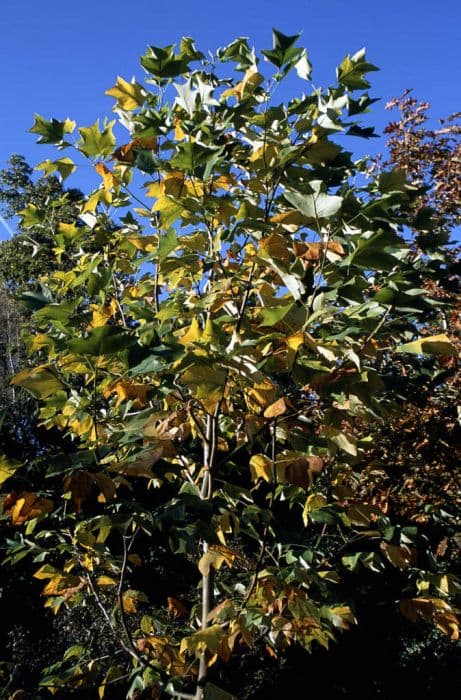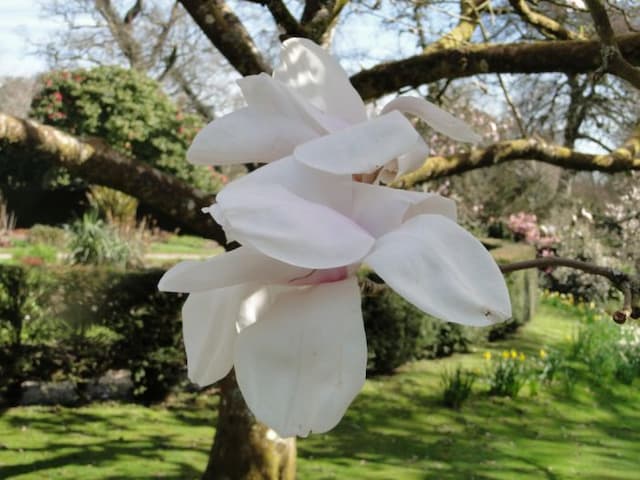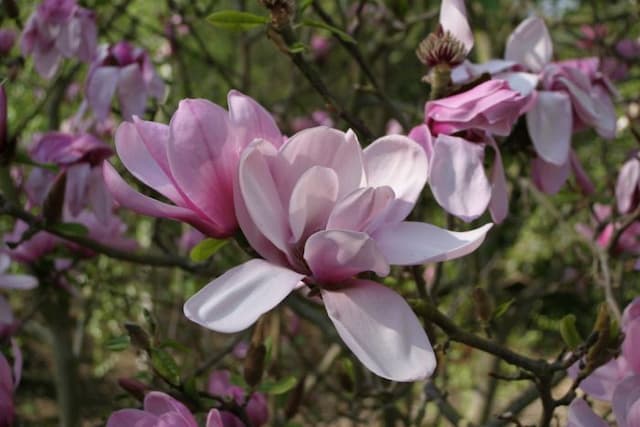Diva Magnolia Magnolia sprengeri var. diva

ABOUT
The Magnolia sprengeri var. diva, commonly known as Diva Magnolia, is a captivating plant prized for its striking floral display. The flowers take center stage on this deciduous tree, with each blossom boasting an impressive size and a delightful fragrance. These spring-blooming flowers emerge on naked branches before the foliage unfurls, creating a breathtaking contrast against the bare wood. The petals are usually a soft pink color, though they can range from a deep rosy hue to a near-white with subtle pink streaks. Inside, bold stamens add to the intricate beauty of the flower. Following the floral spectacle, the plant develops leaves that are broad, glossy, and dark green, providing a lush, dense canopy throughout the summer months. The foliage might turn to vibrant autumnal shades before falling away as the cooler seasons arrive. The Diva Magnolia also bears fruit that are elongated and showy, which eventually split open to reveal bright seeds that dangle on slender threads, adding yet another layer of interest to this already charming plant.
About this plant
 Names
NamesFamily
Magnoliaceae
Synonyms
Diva Magnolia, Sprenger's Magnolia
Common names
Magnolia sprengeri var. diva
 Toxicity
ToxicityTo humans
Magnolia sprengeri, commonly known as Magnolia, is not widely recognised as a toxic plant to humans, and there is limited information about its toxicity. Most magnolias are not considered poisonous. However, as with many plants, it is generally advisable to avoid ingesting parts of the plant because the impact on humans is not thoroughly documented, and individual reactions can vary. If someone were to ingest a significant quantity of any part of the Magnolia plant, they should monitor their health closely and seek medical attention if they experience any adverse symptoms. Typically, concerns with plant ingestion include the risk of gastrointestinal upset or allergic reactions. Since specific toxic compounds and the potential consequences have not been well-established for Magnolia sprengeri, the cautious approach is to avoid consuming any part of the plant.
To pets
Magnolia sprengeri, known simply as Magnolia, is not commonly listed as a toxic plant to pets, including dogs and cats. There's no significant evidence to suggest that Magnolias are harmful to pets, and they are generally not found on toxic plant lists. However, as a precaution, pet owners should discourage their animals from chewing on or ingesting the plant, as it could potentially cause mild gastrointestinal upset in some pets due to the novelty and fibrous nature of the plant material. If a pet ingests parts of a Magnolia plant and shows signs of distress such as vomiting, diarrhea, or unusual behavior, it is recommended to consult a veterinarian. The likelihood of severe poisoning from Magnolia sprengeri is generally low, but individual sensitivities and the potential for obstructive issues if large pieces are ingested should be considered.
 Characteristics
CharacteristicsLife cycle
Perennials
Foliage type
Deciduous
Color of leaves
Green
Flower color
Pink
Height
20 feet [6 meters]
Spread
15 feet [4.5 meters]
Plant type
Tree
Hardiness zones
7
Native area
China
Benefits
 General Benefits
General Benefits- Ornamental Value – Magnolia sprengeri var. 'Diva', commonly known as Diva Magnolia, produces large, showy flowers that are aesthetically pleasing and can enhance the beauty of gardens and landscapes.
- Shade and Shelter – As a tree, it provides shade and can be used to create sheltered areas in gardens, which can be beneficial for relaxing during sunny days or for protecting underplantings.
- Habitat for Wildlife – The tree can attract and support wildlife, providing food in the form of nectar for bees, butterflies, and other pollinators, as well as shelter for birds.
- Fragrance – The blossoms emit a pleasant fragrance that can contribute to a sensory garden experience, making outdoor spaces more inviting.
- Seasonal Interest – Diva Magnolia has a seasonal appeal with its spring blooms and can serve as an indicator of the changing seasons with its flowering habits.
- Cultural Significance – Magnolias have various cultural meanings and are often associated with nobility and perseverance, which can add a layer of meaning to a landscape.
- Privacy – When planted in a row or group, these trees can act as a natural privacy screen, helping to block out noise and sightlines from neighboring areas.
 Medical Properties
Medical Properties- This plant is not used for medical purposes
 Air-purifying Qualities
Air-purifying QualitiesThis plant is not specifically known for air purifying qualities.
 Other Uses
Other Uses- Artistic inspiration: Magnolia sprengeri diva, with its striking pink flowers, often provides inspiration to artists and designers seeking to capture the beauty of nature in their work.
- Floral arrangements: The large, colorful blooms of Magnolia sprengeri diva can be used to create show-stopping floral arrangements for special occasions or as a part of wedding bouquets.
- Scented gardens: When in bloom, the magnolia adds a sweet, pleasantly strong fragrance to gardens, which can be exploited for creating a sensory garden area.
- Dye production: The bark and flowers could potentially be used to create natural dyes for fabrics, though this is not a commonly documented use.
- Cultural ceremonies: In some areas, the flowers may be used in cultural ceremonies or celebrations as symbols of purity and dignity.
- Craft material: Fallen magnolia petals and leaves can be used in crafting, for example, in making bookmarks or adding decorative elements to handmade paper.
- Photography: The striking beauty of Magnolia sprengeri diva makes it a favorite subject for photographers, particularly when seeking images that denote the start of spring.
- Bonsai art: With proper technique, Magnolia sprengeri diva can be grown as a bonsai tree, adding an exotic twist to this traditional Japanese art form.
- Education: The plant can be used as a botanical specimen for educational purposes in schools, parks, and botanical gardens to teach about plant biology and diversity.
- Perfumery: While not a common use, the potent fragrance of Magnolia sprengeri diva's flowers could be captured and used in creating perfumes or scented oils.
Interesting Facts
 Feng Shui
Feng ShuiThe Magnolia is not used in Feng Shui practice.
 Zodiac Sign Compitability
Zodiac Sign CompitabilityThe Magnolia is not used in astrology practice.
 Plant Symbolism
Plant Symbolism- Nobility and Dignity: The magnolia is often associated with nobility and dignity, owing to its striking presence and the fact that it's one of the ancient flowering plants.
- Persistence: Magnolias are also symbolic of persistence because they are hardy plants that can withstand tough conditions and still thrive.
- Beauty and Splendor: With its large, showy flowers, the magnolia is emblematic of beauty and splendor, representing the idea of something visually magnificent.
- Femininity and Yin: In Chinese culture, magnolias are connected with femininity and the yin, or the feminine side of life, due to their soft, large petals.
- Perseverance: The magnolia's ability to survive and bloom each year is seen as a symbol of perseverance, reflecting the plant's resilience.
- Love of Nature: Magnolias can represent an appreciation for the natural world, their size and beauty evoking a love of the environment and open spaces.
 Water
WaterSprenger's Magnolia requires regular watering, especially during dry spells, to keep the soil consistently moist but not waterlogged. Generally, for established trees, water deeply once a week with about 10-15 gallons per session, adjusting for rainfall and temperature. During hot summer months or windy conditions, they might need water more frequently. For newly planted trees, water every few days for the first few months until the root system establishes. Always avoid overhead watering to prevent foliar diseases, and consider using a drip irrigation system or a soaker hose to provide slow, deep watering directly to the root zone.
 Light
LightSprenger's Magnolia thrives best in full sun to partial shade. The ideal spot would provide it with at least four to six hours of direct sunlight each day, with some afternoon shade in hotter climates to protect it from the intense sun. An eastern or western exposure with some protection from the harshest midday sun is optimal, ensuring it gets enough light for healthy growth while minimizing potential stress.
 Temperature
TemperatureSprenger's Magnolia performs best in temperate climates with moderate temperatures. The ideal temperature range is between 70°F and 85°F. While it can tolerate a brief period of temperatures as low as 20°F, sustained cold below this can damage the tree. During summer, it can endure short spells up to 95°F, but prolonged heat can also be detrimental.
 Pruning
PruningPruning Sprenger's Magnolia is generally done to maintain shape and remove dead or damaged branches. Prune in late winter or early spring before new growth begins, as this is when the tree is dormant and less prone to stress. Light pruning can be done annually, but a more thorough pruning should be done every few years. Always use clean, sharp tools to make clean cuts and minimize the risk of disease.
 Cleaning
CleaningAs needed
 Soil
SoilMagnolia sprengeri 'Diva' thrives in a rich, well-draining soil mix with a slightly acidic to neutral pH of 5.5 to 7.0. A mix of loam, peat, and coarse sand or perlite can create the optimal conditions for root health and nutrient uptake.
 Repotting
Repotting'Diva' Magnolias, when grown in containers, require repotting every 2 to 3 years to prevent root bounding and to refresh the soil, ensuring the plant continues to grow healthily.
 Humidity & Misting
Humidity & Misting'Diva' Magnolias prefer moderate to high humidity levels, ideally between 50-70%, to mimic their native woodland environment and support their lush foliage and flowering.
 Suitable locations
Suitable locationsIndoor
Ensure large space, bright indirect light, and moist soil for 'Diva' Magnolia.
Outdoor
Plant in moist, well-drained soil; full sun to part shade; shelter from strong winds.
Hardiness zone
7-9 USDA
 Life cycle
Life cycleMagnolia sprengeri var. diva, commonly known as Diva magnolia, starts its life as a seed, often requiring stratification to break dormancy before germination can occur. Once germinated, the seedling grows into a young sapling, developing a woody stem and a root system to absorb nutrients and water from the soil. As it matures, the sapling grows into a tree with a distinct canopy of large, green leaves. During spring, Diva magnolia enters its reproductive stage, producing fragrant, pink or purplish flowers that attract pollinators for sexual reproduction. Following pollination, the flowers develop into cone-like fruit that releases red-coated seeds, which are dispersed by gravity and sometimes by animals when they fall to the ground. The tree continues to grow and may live for many decades, going through cycles of flowering and seed production annually.
 Propogation
PropogationPropogation time
Spring
The most common method of propagating Magnolia sprengeri var. diva, commonly known as Diva Magnolia, is through semi-hardwood cuttings. This involves taking a cutting from a healthy parent plant during the summer when the current year's growth has begun to harden but is not yet fully woody. The cuttings, typically 4 to 6 inches long, should be taken from the midsection of the branch, with all but the top two or three leaves removed. It's important to make a clean cut and immediately place the cuttings into a rooting hormone before inserting them into a pot filled with a well-draining potting mix. The cuttings should be kept under high humidity and consistent but indirect light until roots have developed, which can take several weeks to a few months. Maintaining a temperature around 75 degrees Fahrenheit (around 24 degrees Celsius) can aid in encouraging root growth.









![Magnolia [Felix Jury]](/_next/image?url=https%3A%2F%2Fplants-admin.emdemapps.com%2Fimages%2Fplants%2F%2Fimages%2F604b61a0b23b7.png&w=640&q=75)